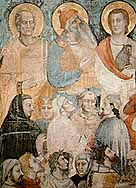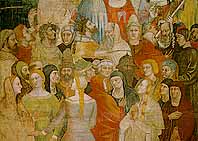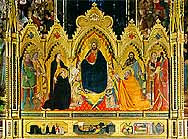
N. di Cione,
The Last Judgement (detail)
The tombs of the Bishop of Fiesole, Tedice Aliotti (1336, monument by Tino di Camaino) and Giuseppe, Patriarch of Constantinople can be seen on the walls on the way back towards to the crossing between the righthand nave and the transept. Giuseppe was the head of the Orthodox Church and died in 1439 during the Council of Florence, which was held in the convent of Santa Maria Novella.

N.
di Cione,
The Last Judgement
The righthand transept is closed off by the Rucellai Chapel, containing
remains of 14th century frescoes and a Martyrdom of St. Catherine by
Giuliano Bugiardini on which Michelangelo is also said to have worked. The
tombstone of Leonardo Dati (1423), General of the Dominican
Order, which was carried out by Lorenzo Ghiberti, can be seen in the centre
of the floor. The Majesty by Duccio di Boninsegna (1285), now in the Uffizi
Gallery, was once placed above the altar of this chapel. The five chapels in
the apse, which can be reached by crossing the transept
from right to left, are the Bardi, Strozzi, Tornabuoni (the chapel at the high
altar), Gondi and Gaddi chapels and take their names from the families that patronized
the church.

Orcagna, Strozzi polyptych
The transept is closed off on the far left by the fourteenth century Strozzi of Mantua Chapel, dedicated to St. Thomas Aquinas, which was untouched by the restoration work carried out by Vasari, thanks to the fact that it contained frescoes by Nardo and Andrea Orcagna (1328-1331). The scenes also show Dante and Petrarch and also an illustration of Hell that reflects the contents of the Divine Comedy: proof that this classic was already extremely well known. The Altarpiece (dated 1357 and still in its original frame) by Orcagna is one of the most important works of fourteenth century Florentine painting.
